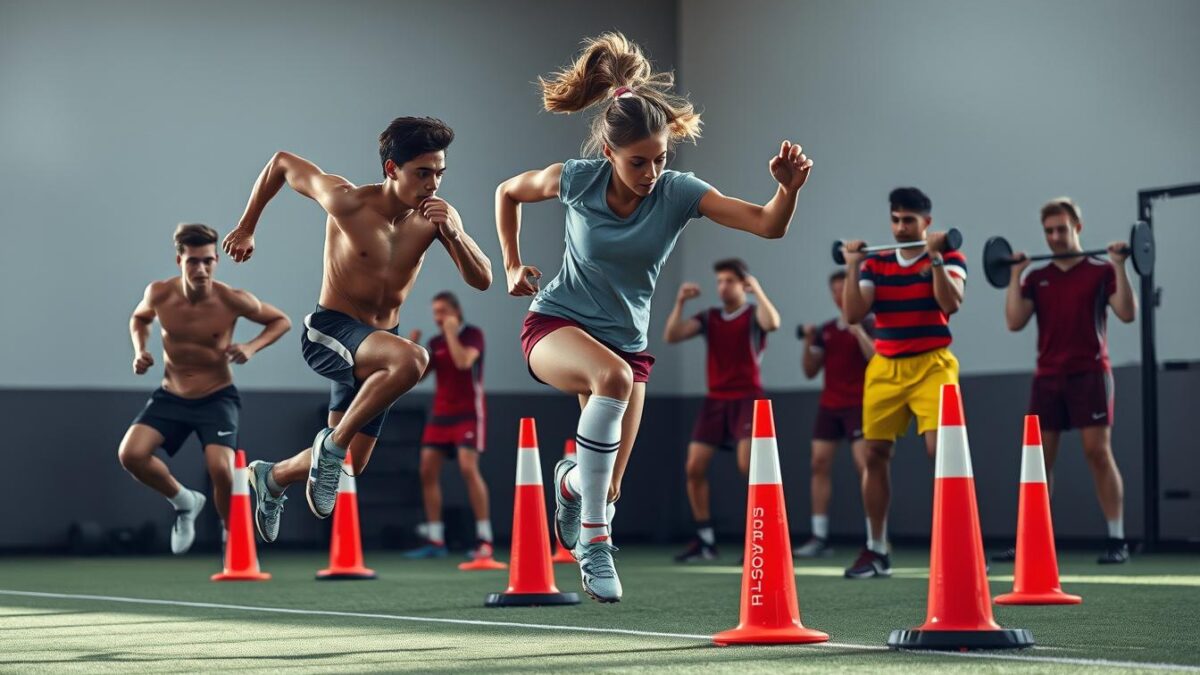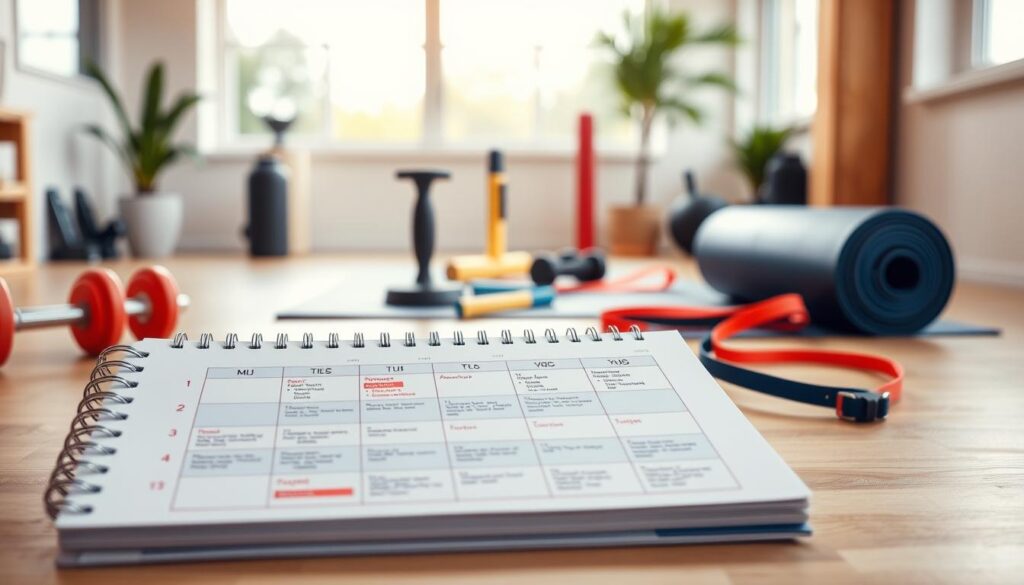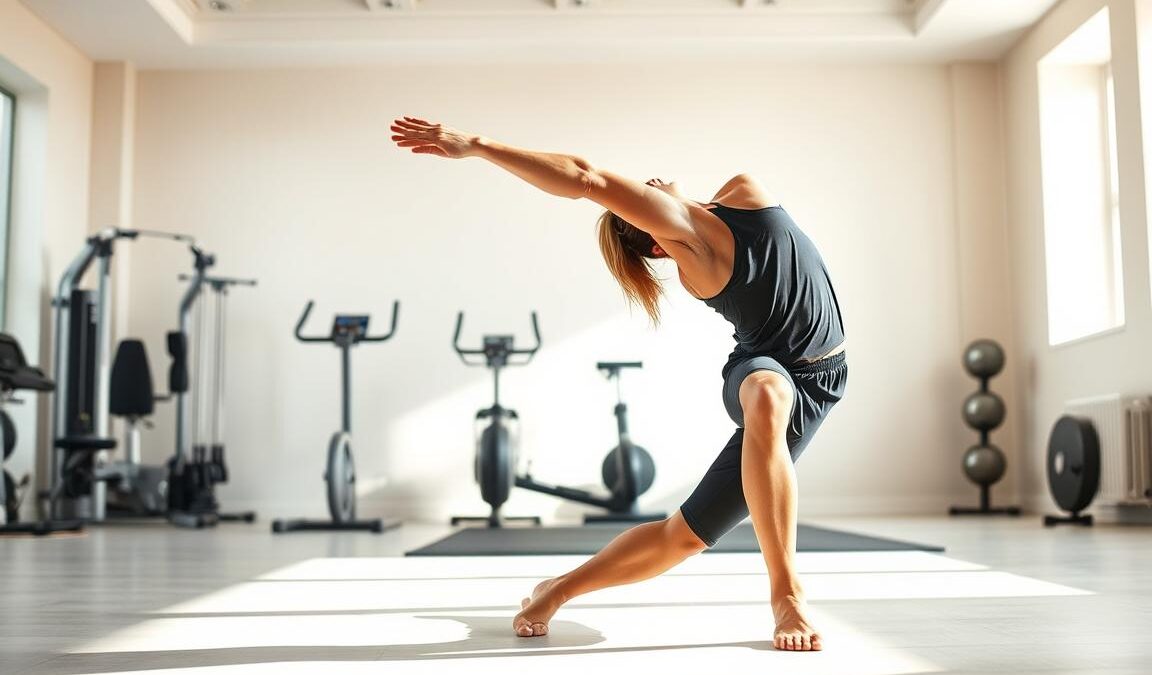
Cross‑Training Routine for Teen Athletes to Build Fitness
Are you searching for a teen athlete cross-training routine? It should boost fitness, strength, and athletic performance. Regular exercise during adolescence is key for lifelong health. We’ll show you how to make your training routine better with varied workouts for teen athletes.
What is Cross-Training and Why is it Important?
Cross-training mixes different exercises to boost fitness. It’s great for young athletes because it works many muscle groups. This helps them grow physically in a balanced way.
It keeps workouts interesting and fun. This makes young athletes love staying active.
For teens in sports, cross-training is key. It lowers the chance of getting hurt from doing the same thing too much. It makes workouts exciting and keeps motivation high.
Young athletes who try cross-training get better at sports. They build a strong base through varied workouts. This boosts their skills in their main sport.
So, cross-training is a smart choice for teens. It improves fitness and makes sports more enjoyable.
Benefits of Cross-Training for Teen Athletes
Cross-training is great for teen athletes. It makes them fitter and better at sports. It’s key for young athletes to know how it helps them grow and compete.
Improved Strength
One big plus of cross-training is getting stronger. Teens can do weight training, bodyweight exercises, and more. This builds muscle and helps bones grow strong.
Being strong is important for sports and health. It helps teens have a balanced body for the long run.
Enhanced Cardiovascular Fitness
Cardio training is another big plus. Activities like running, cycling, or swimming make the heart healthier. They also improve lung function.
Being fit in the heart and lungs means teens can last longer in sports. This boosts their performance in games and fun activities.
Reduced Risk of Injuries
Preventing injuries is key in training. Cross-training helps teens strengthen different muscles. This lowers the risk of injuries from doing the same thing over and over.
It helps the body recover and grow. Learning to mix up exercises improves performance and keeps teens safe from injuries.
Understanding the Needs of Teen Athletes
Teen athletes go through big changes, both in body and mind. It’s key to know what they need to grow and succeed in sports. Training programs should meet their unique needs, helping them physically and mentally.
As they grow, teen athletes need a balanced training plan. This should boost their strength and endurance without harming their developing bodies. A mix of cardio, strength training, and flexibility exercises is best.
Mental toughness is also vital in sports. Training that challenges teens mentally, with support and encouragement, helps build confidence. This positive experience makes them enjoy sports more and stay committed.
Components of an Effective Cross-Training Routine
To create a good cross-training routine, focus on three key areas: strength training, cardio, and flexibility exercises. These elements work together to improve your athletic skills and lower injury chances.
Strength Training
Strength training is vital for building muscle. It helps your body handle physical demands better. Include squats, lunges, and deadlifts in your routine. Adding resistance bands or weights makes your workouts more intense.
Cardiovascular Workouts
Cardio workouts are great for your heart and stamina. Activities like running, biking, or swimming boost endurance. Aim for 150 minutes of moderate cardio each week. Mixing up your cardio keeps things interesting.
Flexibility and Mobility Exercises
Flexibility exercises are key to preventing injuries. Stretching keeps joints and muscles moving freely. Use dynamic stretching in warm-ups and static stretching in cool-downs. Adding yoga or Pilates improves stability and body control.
| Component | Benefits | Examples |
|---|---|---|
| Strength Training | Develops muscle strength and power, supports joint health | Squats, Push-ups, Deadlifts |
| Cardiovascular Workouts | Improves heart health, boosts endurance, maintains healthy weight | Running, Cycling, Swimming |
| Flexibility Exercises | Enhances range of motion, reduces injury risk, improves posture | Yoga, Static stretching, Dynamic stretching |
Creating a Balanced Weekly Cross-Training Schedule
Creating a balanced cross-training schedule for teen athletes means mixing different exercises. This helps improve performance and ensures they get enough rest. The NHS suggests at least 60 minutes of physical activity each day. This should include both cardio and strength training.
A balanced weekly cross-training schedule might look like this:
| Day | Workout Type | Duration |
|---|---|---|
| Monday | Strength Training (Upper Body) | 60 minutes |
| Tuesday | Cardiovascular Workout (Running/Cycling) | 60 minutes |
| Wednesday | Flexibility and Mobility Exercises | 30 minutes |
| Thursday | Strength Training (Lower Body) | 60 minutes |
| Friday | Mixed Cardio (Swimming/HIIT) | 30-45 minutes |
| Saturday | Rest or Light Activity (Yoga/Walking) | 30 minutes |
| Sunday | Active Recovery (Family Sports) | 60 minutes |
This varied schedule boosts strength, endurance, and flexibility. It also includes rest days for recovery. Mixing up exercises keeps athletes engaged and balanced. Always listen to your body and tweak the schedule as needed.

Essential Exercises for a Teen Athlete Cross-Training Routine
For teen athletes, building a strong fitness base is key. Adding essential exercises to a cross-training routine can really help. Bodyweight training is great for building strength and coordination anywhere. Using fitness equipment for teens can make workouts more varied and effective. Let’s look at some top exercises for these needs.
Bodyweight Exercises
Bodyweight exercises are easy and effective for building strength without special gear. Here are some key ones:
- Push-ups: Great for upper body strength, focusing on the chest, shoulders, and triceps.
- Squats: A basic exercise that works the legs and glutes, also improving core stability.
- Planks: Excellent for strengthening the core, boosting performance in various sports.
- Lunges: Build leg strength and improve balance, key for agility in sports.
Utilizing Fitness Equipment
Adding fitness equipment can make workouts better and target muscles more effectively. Here are some must-haves:
- Dumbbells: Versatile and perfect for adding resistance to exercises like rows and shoulder presses.
- Resistance bands: Great for a variety of exercises that boost strength and flexibility.
- Kettlebells: Useful for dynamic movements that improve strength and cardiovascular fitness.
Mixing bodyweight training with fitness equipment helps teen athletes build a well-rounded routine. This routine strengthens muscles, improves coordination, and boosts performance. Include dynamic exercises from this resource for the best results.
Incorporating Sport-Specific Training
General cross-training is a good start, but adding sport-specific training boosts your performance. Tailoring workouts to your sport helps build the right strength, agility, and endurance. This is key for success.
First, identify the main skills needed in your sport. For instance, a basketball player might work on agility and shooting. A soccer player should focus on footwork and stamina.
Sport-specific training can take many forms:
- Practice drills that mimic game scenarios, allowing for improved decision-making and technique under pressure.
- Include plyometric exercises to enhance explosive strength, which is vital in sports like football and basketball.
- Use agility ladders or cones to improve quick foot movements, important in many sports.
Adding these drills to your cross-training routine improves your athletic skills. It also deepens your understanding of your sport’s demands. A mix of general fitness and specific skills makes your training effective for competition.
Nutrition for Teen Athletes During Cross-Training
Proper nutrition is key for teen athletes to get the most out of their cross-training. Meals should have the right balance of carbs, proteins, and fats. This mix boosts energy and helps with recovery after hard workouts. Good nutrition is essential for better performance and health.
Creating meal plans tailored for growing athletes is a good idea. These plans should include foods rich in nutrients to fuel workouts and provide important vitamins and minerals.
- Complex Carbohydrates: Whole grains, fruits, and veggies should be a big part of meals. They give the energy needed for training.
- Lean Proteins: Foods like chicken, fish, beans, and legumes help muscles repair and grow.
- Healthy Fats: Avocados, nuts, and olive oil are good for overall health and give lasting energy.
Drinking enough water is also critical for teen athletes. It keeps performance up, prevents fatigue, and stops cramps. Athletes should drink water all day and before, during, and after workouts.
Here’s a sample meal plan for teens to balance their nutrition while cross-training:
| Meal | Food Items | Key Nutrients |
|---|---|---|
| Breakfast | Oatmeal with banana and honey | Carbohydrates, potassium, fiber |
| Snack | Greek yogurt with berries | Protein, antioxidants |
| Lunch | Grilled chicken salad with mixed greens | Lean protein, vitamins, healthy fats |
| Snack | Nuts and an apple | Healthy fats, fiber, carbohydrates |
| Dinner | Salmon, quinoa, and steamed broccoli | Omega-3s, complex carbohydrates, vitamins |
By focusing on nutrition tailored for teen athletes, they can fuel their workouts better. This helps improve their athletic performance overall.
Common Mistakes to Avoid in a Cross-Training Program
Many teen athletes start their cross-training journey with excitement. But, they often make common mistakes. One big mistake is overtraining. This can lead to fatigue and a higher chance of getting hurt.
It’s important to listen to your body and know when to take a break. This helps avoid injuries and keeps you going strong.
Another mistake is ignoring flexibility and mobility exercises. Young athletes often focus too much on strength and cardio. But, being flexible is key for better performance and staying injury-free.
Adding a variety of exercises helps keep your body balanced. This ensures you’re working on all aspects of fitness.
Having a clear plan can help avoid these mistakes. Make sure to include rest days, different workouts, and check in with yourself. This keeps you motivated and safe while training.
By keeping a balance, teen athletes can make the most of their training. They’ll reach their fitness goals more effectively.
Tracking Progress and Setting Goals
For teen athletes, tracking fitness progress and setting goals is key. It helps them improve. Using technology, like fitness apps and training logs, makes tracking easier. It boosts motivation by showing how far they’ve come.
Using Apps and Training Logs
Fitness apps like MyFitnessPal or Strava help record workouts. They show progress clearly. They also remind athletes to stay consistent with their training.
Training logs, digital or paper, track exercises and sets. They highlight strengths and areas to improve. This is vital for growth.
Setting goals is also important. Goals keep athletes motivated and focused. Here are some tips for setting goals:
- Make goals specific and measurable, like running a 5K in under 25 minutes.
- Break big goals into smaller steps. Each step builds confidence.
- Check progress often and adjust goals as needed. Being flexible helps with challenges.
- Always celebrate achievements, no matter how small. It keeps motivation high.
Tracking progress and setting goals helps teen athletes grow. It builds confidence and understanding of their fitness journey. This makes their fitness path more rewarding.
Encouraging Social Interaction Through Cross-Training
For teen athletes, fitness should never be alone. Cross-training is great for meeting new people. It lets young athletes work out with friends, building a strong fitness community.
Working out with friends makes it more fun. It helps teens make friends and feel supported. When they see others working hard, they get motivated too.
Group training turns fitness into a team effort. It helps teens reach their goals and feel better mentally. Working out with friends makes every session a positive experience.



